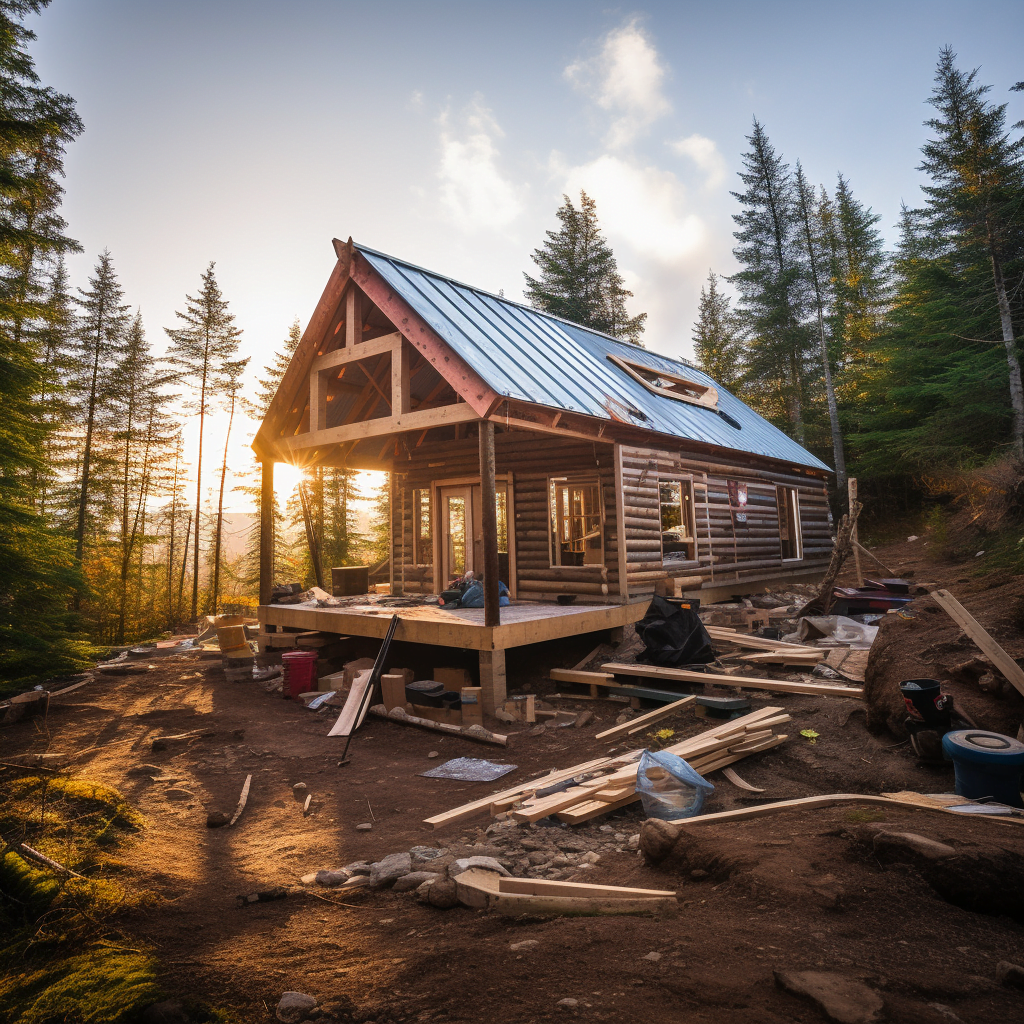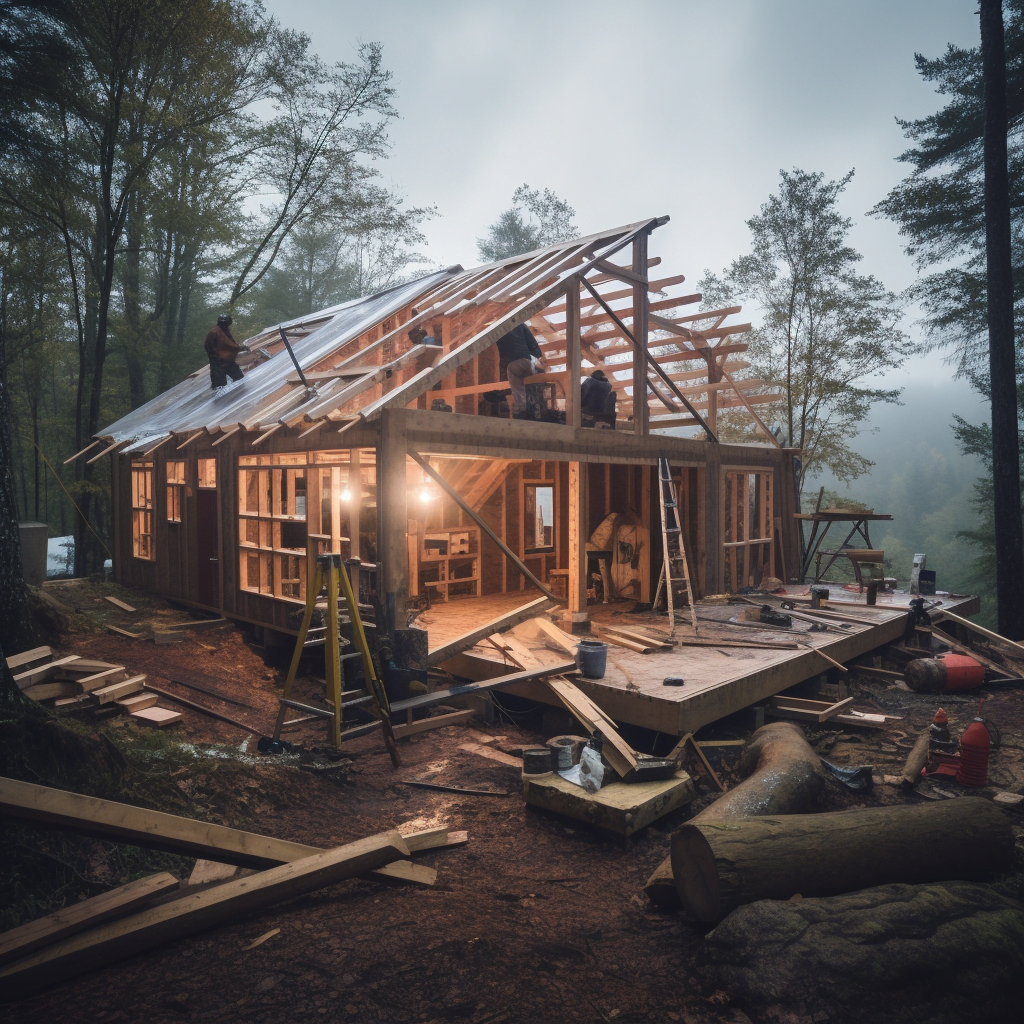Introduction to Off Grid Living
Go off-grid and take control of your own destiny! Imagine living without the hustle and bustle of society, using renewable energy sources and your own skills to thrive.
Generate your own power through solar panels or wind turbines. Harvest rainwater for daily use. Utilize compost systems for waste management. Plant sustainable gardens to grow your own food. And use natural resources for heating and cooking. Reduce your carbon footprint and enjoy a more eco-friendly lifestyle.
Besides environmental benefits, off-grid living offers mental clarity and tranquility away from the city. Connect with nature and appreciate the beauty of your surroundings. Enjoy a deep sense of peace.
Before taking this journey, research building codes in your area. Make sure your off-grid cabin is compliant with regulations. Then, leave the chaos of the modern world and live in harmony with nature!
Understanding the Basics of Off Grid Cabins
The fundamentals of off-grid cabins focus on self-sufficiency and sustainable living. These cabins are built to operate independently from public utilities. They use renewable energy sources such as solar panels and rainwater harvesting systems. It’s a chance to break away from the grid and embrace a simpler lifestyle.
Living off the grid needs planning. Off grid cabins normally use alternative energy sources like solar, wind turbines, or hydroelectric power. This lets people generate their own electricity and reduce their use of traditional grids. Plus, cabins often employ passive design techniques to save energy, like right insulation and pointing towards natural light.
Water is another big factor of off grid living. Cabins can collect rainwater through gutters and tanks, so they have a sustainable water source. Recycling and responsible water management are key for self-sufficiency.
Off grid cabins give people an opportunity to get close to nature while lowering their environmental impact. Using sustainable materials during construction and adopting low-waste lifestyles helps occupants live in harmony with their surroundings. Plus, they can enjoy outdoor activities like gardening, hiking, or simply observing wildlife.
The importance of off grid living dates back to the early 20th century when writer Henry David Thoreau built his cabin near Walden Pond in Massachusetts. Thoreau’s experience was about self-reliance and a simpler life. His book “Walden” still inspires those wanting a break from conventional norms.
Living in off-grid cabins is more than an escape from cities; it’s a chance to lead a sustainable lifestyle that fits one’s values and respects the environment. In this era of climate change and limited resources, understanding the basics of off-grid cabins is essential for those who want a more conscious way of living. Finding the perfect spot for an off-grid cabin is like searching for a unicorn – hard to find!
Choosing the Perfect Location for Your Off Grid Cabin
Choosing the perfect spot for your off-grid cabin is a must. It will determine the success of your cabin and your whole living experience. Here are some tips:
- Think of access to amenities such as medical care, transportation and groceries. Though seclusion is great, find a balance between isolation and convenience.
- Look for a location abundant in natural resources like water sources and fertile soil. These are very important if you want to be self-sustaining.
- Check the amount of sunlight the location receives annually. Solar energy is key to powering your off-grid cabin.
Also, consider any unique details that can add to your joy of living off-grid. Think of recreational activities or nice landscapes nearby.
Besides these tips, here are 3 more pieces of advice:
- Get to know the local community. This gives you access to resources, security and a sense of belonging.
- Do some soil testing. Make sure the soil is suitable for gardening or farming.
- Ask an expert. Seek professional guidance from someone who specializes in sustainable living.
With proper research and foresight, you can find the perfect location for your off-grid cabin. Sometimes you might have to compromise, but you’ll be able to find a fantastic spot that feels like home.
Designing and Planning Your Off Grid Cabin
Designing and Planning Your Off-Grid Cabin – 8 Things To Consider!
Location: Pick the right spot, with easy access and near resources.
Size and Layout: Consider how many rooms, bathrooms and living areas you need.
Energy Sources: Investigate renewable options like solar and wind.
Water Supply: Get water through rainwater or drilling a well.
Waste Management: Set up composting or septic tanks.
Building Materials: Go eco-friendly and durable.
Permits and Regulations: Learn local regulations.
Budget: Establish a budget for the design, plan and construction.
Throughout time, people have been captivated by living off-grid – from self-sufficiency to closeness with nature. Log cabins were built using locally sourced materials, showing resourcefulness and adaptability. Off-grid cabins still offer a unique lifestyle – allowing independent living in harmony with nature. Sustainable energy solutions are like the ultimate goals for these cabins – they provide warmth and light, and never complain about snoring.
Sustainable Energy Solutions for Off Grid Cabins
Sustainable energy solutions for off-grid cabins are a must. Not relying on traditional electrical grids, these solutions provide power you can trust. Here are four to think about:
- Solar Power
- Wind Turbines
- Hydroelectric Systems
- Biomass Energy
Each cabin’s needs are unique, so keep that in mind when choosing.
Mark’s story shows how it works. For his mountain cabin, solar panels & storage batteries were the go-to. His success was remarkable, inspiring others. Sustainable energy sources make it possible to enjoy reliable power while caring for the environment. It’s a greener future!
Water and Sewage Management for Off Grid Cabins
Water and sewage management is essential for off-grid cabins. Without these systems, access to clean water and effective waste disposal can be difficult. This article will discuss the different aspects of water and sewage management for off-grid cabins.
The following components are key when it comes to managing water and sewage for off-grid cabins:
| Component | Function |
|---|---|
| Water filtration system | Purifies water from natural sources |
| Rainwater harvesting | Collects rainwater for various uses |
| Composting toilets | Decomposes waste into nutrient-rich compost |
| Greywater treatment | Cleans and filters wastewater for reuse |
| Septic tank | Stores and decomposes solid waste |
To optimize these systems, activated carbon filters are great for water filtration and constructed wetlands can be used to treat greywater. When considering water supply, take into account rainfall patterns and storage capacity. Installing large rainwater tanks or cisterns can help reduce potential water shortages.
If you’re planning an off-grid cabin, remember to give priority to water and sewage management. By utilizing systems such as water filtration, rainwater harvesting, composting toilets, greywater treatment, and septic tanks, you can benefit from a sustainable lifestyle while minimizing your environmental impact. Don’t miss out on the opportunity to create a self-sufficient oasis in nature!
Off Grid Cabin Construction Methods and Materials
Constructing an off-grid cabin requires thoughtful choice of methods and materials for sustainability and autonomy. Here are 6 key points to consider:
- Foundation: Pick a robust foundation, like concrete or pier blocks, that can endure the harsh conditions and support the cabin’s weight.
- Structural Materials: Utilize renewable materials like timber frame or straw bales for walls, giving strength and insulation.
- Solar Power: Install solar panels to capture renewable energy, supplying lighting, appliances and other necessities.
- Rainwater Collection: Include a rainwater collection system for an independent water source, reducing reliance on outside water.
- Compost Toilets: Prefer compost toilets over traditional flush toilets, limiting water use and managing waste efficiently.
- Energy-efficient Design: Aim to design the cabin with insulation, orientation and window placement to maximize energy efficiency.
Moreover, think about special details like natural ventilation systems or reclaimed materials for a greener approach.
For centuries, people have been constructing off-grid cabins to live away from mainstream society. As technology and knowledge advance, the techniques and materials may vary, but the core principles stay the same – building a home that blends with nature and provides autonomy and comfort. Who needs electricity and running water when you can have a warm off-grid cabin and enhanced wilderness survival skills?
Essential Amenities for a Comfortable Off Grid Lifestyle
For a comfortable off-grid lifestyle, you need reliable and sustainable sources of power, efficient water management systems, and a well-designed waste disposal system.
- Power: Solar panels and wind turbines provide electricity.
- Water Management: Rainwater and rivers can be collected, stored and purified with a robust water management system.
- Waste Disposal: Composting toilets and recycling facilities keep the cabin clean and eco-friendly.
Details matter too. High-quality batteries guarantee power even when it’s cloudy. Graywater systems reuse water for irrigation. And energy-efficient appliances and sustainable gardening are important for comfortable living.
Interest in off-grid living is growing. REN21 found that, in 2017, 157 gigawatts of renewable power were added globally. A sign of the times! Who needs wifi when you have a cabin that’s off the grid? It’s like going back in time, with more mosquito bites and less plague.

Maintaining and Enhancing Your Off Grid Cabin
For an off-grid cabin that’s comfortable and sustainable, regular inspections are key. Look for roof, wall, and foundation issues before they turn into costly repairs. Renewable energy sources like solar panels or wind turbines can reduce reliance on traditional power sources and minimize your carbon footprint. Water management systems, such as rainwater harvesting or filtration, are essential for conserving water. To create an inviting outdoor space, use native plants, build a patio, or set up a fire pit. Eco-friendly materials such as reclaimed wood and natural insulation can make your living space stylish and sustainable. Taking the time to maintain and enhance your off-grid cabin will ensure a harmonious connection with nature. Embrace the off-grid lifestyle! Nothing says ‘freedom’ like trekking through the woods every time nature calls.
Conclusion: Embracing the Off Grid Lifestyle
Living off-grid offers a unique opportunity to be immersed in nature, free from public utilities. Prioritizing energy efficiency when constructing a cabin is key. To do this, select a site with ample sunlight and access to water. Insulate with natural materials, optimize natural lighting, and incorporate rainwater harvesting and compost toilets.
Learning new skills like growing food and generating power sustainably is part of the off-grid journey. Permaculture principles can help build resilient ecosystems. Connecting with like-minded people facilitates knowledge exchange and resource sharing.
Henry David Thoreau’s experiment at Walden Pond serves as an inspiring example of embracing the off-grid lifestyle. His writings show how one can find fulfillment through an alternative way of life.




